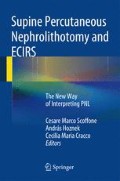Abstract
It is essential to clearly define the indications for PNL according to established guidelines for the treatment of urolithiasis. A thorough preoperative workup should identify stone (size, location, composition and hardness) and patient features (including special situations like urinary malformations, skeletal deformities, paediatric age or pregnancy), in order to define the indication to the percutaneous approach and possibly find out the best candidates for the supine position.
Access this chapter
Tax calculation will be finalised at checkout
Purchases are for personal use only
References
Preminger GM, Assimos DG, Lingeman JE et al (2005) Nephrolithiasis guideline panel Chapter 1, AUA guidelines on management of staghorn calculi: diagnosis and treatment recommendation. J Urol 173:1991–2000
Türk C, Knoll T, Petrik A et al (2012) Guidelines on urolithiasis, European Association of Urology. http://www.uroweb.org/gls/pdf/20_Urolithiasis_LR%20March%2013%202012.pdf
Denstedt J, Khoary S (2008) Stone disease. In: 2nd international consultation on stone disease. Health Publications (Editions 21), Paris
Worster A, Preyra I, Weaver B et al (2002) The accuracy of non contrast helical computed tomography versus intravenous pyelography in the diagnosis of suspected acute urolithiasis: a meta-analysis. Ann Emerg Med 40:280–286
Morcos SK, Thomsen HS, Webb JA (2001) Contrast media safety committee of the European society of urogenital radiology prevention of generalized reactions to contrast media: a consensus report and guidelines. Eur Radiol 11:1720–1728
Thomsen HS, Morcos SK (2003) Contrast media and the kidney: European society of urogenital radiology (ESUR) guidelines. Br J Radiol 76:513–518
Aga P, Bansal R (2010) Is intravenous urogram no longer an imaging of choice for percutaneous nephrolithotomy? Indian J Urol 26:303–304
Mishra S, Sabnis RB, Desai MR (2012) Staghorn morphometry: a new tool for clinical classification and prediction model for percutaneous nephrolithotomy monotherapy. J Endourol 26:6–14
Tiselius HG, Ackermann D, Alken P et al (2001) Working party on lithiasis, European Association of Urology. Eur Urol 40:362–371
Teichman JM, Long RD, Hulbert JC (1995) Long term renal fate and prognosis after staghorn calculus management. J Urol 153:1403–1407
Meretyk S, Gofrit ON, Gafni O et al (1997) Complete staghorn calculi: randomized prospective comparison between extracorporeal shock wave lithotripsy monotherapy and combined with percutaneous nephrolithotomy. J Urol 157:780–786
Lingeman JE, Siegel YI, Steele B (2005) Management of lower pole nephrolithiasis. J Urol 173:469–473
Albala DM, Assimos DG, Clayman RV et al (2001) A prospective randomized trial of extracorporeal shock wave lithotripsy and percutaneous nephrostolithotomy for lower pole nephrolithiasis: initial results. J Urol 166:2072–2080
Turna B, Raza A, Moussa S et al (2007) Management of calyceal diverticular stones with extracorporeal shock wave lithotripsy and percutaneous nephrolithotomy: long term outcome. BJU Int 100:151–156
Wen CC, Nakada SY (2007) Treatment selection and outcomes: renal calculi. Urol Clin North Am 34:409–419
Shah K, Kurien A, Mishra S et al (2010) Predicting effectiveness of extracorporeal shockwave lithotripsy by stone attenuation value. J Endourol 24:1169–1173
El Nahas AR, El Assmy AM, Manour O et al (2007) A prospective multivariate analysis of factors predicting stone disintegration by extracorporeal shock wave lithotripsy: the value of high resolution non contrast computed tomography. Eur Urol 51:1688–1693
Author information
Authors and Affiliations
Corresponding author
Editor information
Editors and Affiliations
Rights and permissions
Copyright information
© 2014 Springer-Verlag France
About this chapter
Cite this chapter
Ganpule, A.P., Desai, M.R. (2014). PNL: Indications and Guidelines: Urolithiasis. In: Scoffone, C., Hoznek, A., Cracco, C. (eds) Supine Percutaneous Nephrolithotomy and ECIRS. Springer, Paris. https://doi.org/10.1007/978-2-8178-0459-0_4
Download citation
DOI: https://doi.org/10.1007/978-2-8178-0459-0_4
Published:
Publisher Name: Springer, Paris
Print ISBN: 978-2-8178-0359-3
Online ISBN: 978-2-8178-0459-0
eBook Packages: MedicineMedicine (R0)

